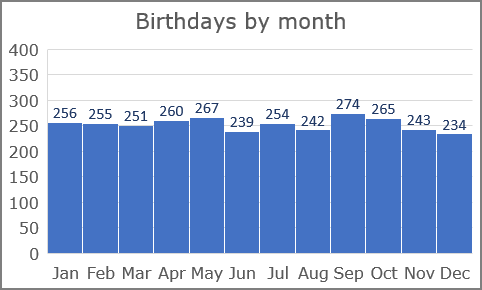

You can always ask an expert in the Excel Tech Community or get support in the Answers community. Create the Histogram Assuming you’ve entered all the values for your dataset, select all the values that should be included in the histogram. The output of the histogram analysis is displayed on a new worksheet (or in a new workbook) and shows a histogram table and a column chart that reflects the data in the histogram table. If you omit the bin range, Excel creates a set of evenly distributed bins between the minimum and maximum values of the input data.
#HOW TO MAKE A HISTOGRAM IN EXCEL 2016 FOR PC HOW TO#
Click here to learn how to add Excel 2016 Histogram. A data point is included in a particular bin if the number is greater than the lowest bound and equal to or less than the greatest bound for the data bin. Histogram Charts in Excel are very visual as it can easily show you the distribution of numerical data. When you use the Histogram tool, Excel counts the number of data points in each data bin. Input data This is the data that you want to analyze by using the Histogram tool.īin numbers These numbers represent the intervals that you want the Histogram tool to use for measuring the input data in the data analysis. These columns must contain the following data: You must organize the data in two columns on the worksheet. To create a histogram in Excel, you provide two types of data - the data that you want to analyze, and the bin numbers that represent the intervals by which you want to measure the frequency. If you used column labels on the worksheet, you can include them in the cell references. First, some definitions: Histograms analyze numerical data Frequency distributions analyze categorical (text) data Create a Histogram in Microsoft Excel 2016 Excel 2016 has a easier way to create histograms than Excel 2013.

In the Bin Range box, enter the cell reference for the range that has the bin numbers. Create new section header and footer word for mac.

Fill the first column with the frequency of results for that group (called the grade), or the levels that you want the bars for that group to be at. In the Input Range box, enter the cell reference for the data range that has the input numbers. In an open Excel document, fill the second column with the 'bins', or data groups that you want (20/30/40, 0/5/10/15, etc) with one group per cell. If you don't enter any bin numbers, the Histogram tool will create evenly distributed bin intervals by using the minimum and maximum values in the input range as start and end points. It’s a good idea to use your own bin numbers because they may be more useful for your analysis. In the next column, type the bin numbers in ascending order, adding a label in the first cell if you want. The Histogram tool won’t work with qualitative numeric data, like identification numbers entered as text. On a worksheet, type the input data in one column, adding a label in the first cell if you want.īe sure to use quantitative numeric data, like item amounts or test scores. For more information, see Load the Analysis ToolPak in Excel. Make sure you have loaded the Analysis ToolPak.


 0 kommentar(er)
0 kommentar(er)
